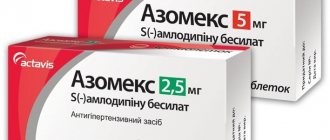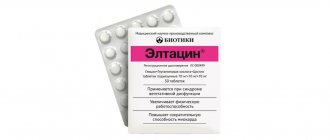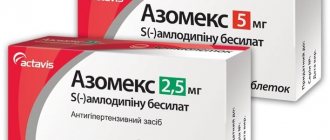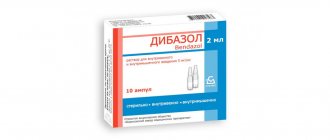Component composition of Milgamma
The instructions specify that each form of the drug contains its own ingredients. The component composition is presented:
- pyrodoxine and thiamine hydrochloride;
- cyanocobalamin;
- lidocaine hydrochloride;
- phenylcarbinol;
- potassium hexacyanoferrate;
- caustic soda;
- food additive E452;
- sterile water.
The tableted components are presented:
- benfotiamine;
- pyridoxine hydrochloride;
- Silicii dioxydum colloidale;
- croscarmellose sodium;
- food additive E460;
- povidone K 30;
- partial long-chain glycerides;
- talcum powder
The medicine Milgamma is made in 3 types: tablets, solution, dragees.
It contains subgroup B vitamins, the medicine is used for therapy:
- NS diseases – with inflammation and degenerative processes, impaired conduction of impulses;
- pathologies of the musculoskeletal system - the medication suppresses discomfort, improves local blood circulation, stabilizes the functioning of the hematopoietic organs.
Lidocaine, which is included in the composition, anesthetizes at the local level.
To whom is Milgamma prescribed and prohibited?
The instructions recommend the use of tablets for complex therapy of pathologies of the nervous system of various etiologies. Procedures are prescribed:
- for neuritis, neuralgia;
- paresis of the facial nerve;
- neuropathies, plexopathies;
- ganglionitis;
- diabetic or alcoholic polyneuropathy.
The solution and tablets are prescribed as part of the complex treatment of diseases and syndromes of the nervous system that have different origins. The injectable form of the drug is used for nocturnal convulsive syndrome, neurological symptoms caused by spinal osteochondrosis.
The instructions indicate the following contraindications for patients:
- with individual intolerance to the component composition;
- decompensated heart failure.
Injections and tablets are not prescribed to pregnant, lactating women, or minor patients.
Functions and sources of B vitamins
The group of B vitamins is quite extensive: eight vitamins. They are united by a similar chemical composition, but have different properties, purpose and number. B vitamins are water soluble and play a very important role in metabolism.
It is very important that a person’s diet includes foods that contain these vitamins. So, 8 B vitamins:
- B1, or thiamine.
This vitamin was one of the first to be discovered by the entire group. The vitamin of vivacity and spirit is considered an “anti-nervous” vitamin because it has a positive effect on the functioning of the nervous system and brain function. Thiamine converts carbohydrates into energy, supports muscle function and heart function9. This vitamin can be found mainly in plant foods: cereals, sprouted grains, cereals, bran, etc. - B2, or riboflavin,
is involved in the production of erythrocytes - red blood cells, also takes part in the metabolism of carbohydrates and fats, is indispensable for healthy skin, nails, hair growth, promotes growth, and prevents cancer formations. It is important for the process of iron absorption and hemoglobin synthesis. This vitamin is found in green vegetables, mushrooms, pasta, bread, fish, milk and meat9. - B3(PP), or nicotinic acid,
helps to establish enzymatic processes and is involved in carbohydrate and cholesterol metabolism. Promotes successful absorption of all nutrients. The most vitamin B3 is found in eggs, fish, meat, kidneys, liver, buckwheat, and green vegetables. - B5, or pantothenic acid,
plays an important role in metabolism, in the metabolism of proteins, carbohydrates and fats, participates in the formation of a strong immune system, increases hemoglobin in the blood, normalizes the functioning of the thyroid gland, adrenal glands and nervous system. Pantothenic acid is found in eggs, meat and fish products, brewer's yeast, soybeans and mushrooms9. - B6, or pyridoxine,
has a beneficial effect on metabolism, many metabolic processes occur with its participation - it regulates the action of enzymes, has a beneficial effect on the function of the nervous system, liver, hematopoiesis, on the immune, nervous and cardiovascular systems10. In the human body, about 80% of vitamin B6 is found in muscles, liver, myocardium and kidneys. Without it, the synthesis of neurotransmitters (substances that are responsible for mood and brain function) and the synthesis of prostaglandins (substances that regulate heart function and blood pressure) are impossible. There is a lot of pyridoxine in nuts, especially walnuts and hazelnuts, tomatoes, carrots, cereals, cabbage, citrus fruits, berries (strawberries, cherries). - B7, or biotin,
is important for regulating blood sugar levels, as it is part of the enzymes involved in glucose metabolism. Vitamin B7 is also responsible for the normal functioning of the sweat and male gonads, nervous, immune and digestive systems, bone marrow, skin and hair. The richest sources of vitamin B7 are the liver and kidneys of large animals, yeast, legumes (soybeans, peanuts), cauliflower, nuts, boiled eggs, spinach, and beets10. - B9, or folic acid,
is necessary for growth, development of the circulatory and immune systems. It is especially important in the first trimester of pregnancy for the formation of the fetal nervous system. Contained in green vegetables (parsley, celery, spinach, cabbage), as well as tomatoes, legumes, nuts, beets, bananas9. - B12, or cyanocobalamin,
is responsible for the growth and development of the nervous system and promotes the formation of nucleic acids. B12 is found only in products of animal origin: poultry meat, offal (liver, heart), seafood, sea fish, eggs9.
Adverse reactions
Non-standard responses of the body in response to Milgamma therapy occur in exceptional cases. Patients may experience:
- with allergy symptoms - obsessive itching, redness in certain areas of the skin, dermatological rash;
- attacks of dizziness, disturbances in clarity of consciousness;
- changes in heart rhythm, fast or slow heartbeat;
- vomiting, acne, active work of sweat glands, convulsive syndrome.
With intravenous injections, local irritation may occur at the entry point. Systemic reactions occur when an overdose of a drug or rapid administration of a solution occurs.
The occurrence of any side effects, including those not described, requires consultation with your doctor. After studying the problem, the specialist will change the treatment regimen and prescribe a safer medicine.
Milgamma therapy
The instructions describe in detail detailed information about permissible dosages and duration of treatment. Intramuscular injections of 2 ml of the drug are administered daily, from 5 to 10 days in a row. During maintenance therapy, a similar amount of Milgamma is prescribed up to 3 times a week.
Quick relief of painful sensations is achieved by regularly taking tablets or injections. Procedures can last up to one calendar month, and health monitoring by medical professionals is carried out weekly. Experts believe that a quick transition to oral pills has a better effect on the body’s condition.
An increase in therapy is prescribed by the attending physician and may exceed the 10 days recommended by the instructions. The choice of the form of medication is carried out for each patient individually. Milgamma is not available in suppositories.
MILGAMMA DRAGEE 100 MG No. 60
Compound
Active ingredients: thiamine hydrochloride - 100 mg;
pyridoxine hydrochloride - 100 mg; cyanocobalamin - 1 mg; lidocaine hydrochloride - 20 mg Excipients: benzyl alcohol - 40 mg; sodium polyphosphate - 20 mg; potassium hexacyanoferrate - 0.2 mg; sodium hydroxide - 12 mg; water for injection - up to 2 ml.
Description of the dosage form
Dragee
pharmachologic effect
Pharmacological action - metabolic, neuroprotective, analgesic.
Pharmacodynamics
Neurotropic B vitamins have a beneficial effect on inflammatory and degenerative diseases of the nerves and musculoskeletal system. Thiamine plays a key role in carbohydrate metabolism, as well as in the Krebs cycle with subsequent participation in the synthesis of thiamine pyrophosphate and ATP. Pyridoxine is involved in protein metabolism and partially in the metabolism of carbohydrates and fats. The physiological function of both vitamins is to potentiate each other’s action, manifested in a positive effect on the nervous and neuromuscular systems. Cyanocobalamin is involved in the synthesis of the myelin sheath, reduces pain associated with damage to the peripheral nervous system, and stimulates nucleic acid metabolism through the activation of folic acid. Lidocaine is a local anesthetic that causes all types of local anesthesia: terminal, infiltration, conduction.
Pharmacokinetics
After intravenous administration, thiamine is quickly absorbed from the injection site and enters the blood (484 ng/ml after 15 minutes on the first day of administration of a 50 mg dose) and is distributed unevenly in the body with its content in leukocytes - 15%, erythrocytes - 75% and in plasma - 10%. Due to the lack of significant reserves of the vitamin in the body, it must be supplied to the body daily. Thiamine penetrates the blood-brain and placental barriers and is found in breast milk. Thiamine is excreted in the urine in the alpha phase after 0.15 hours, in the beta phase after 1 hour and in the terminal phase within 2 days. The main metabolites are: thiaminecarboxylic acid, pyramine and some unknown metabolites. Of all the vitamins, thiamine is stored in the body in the smallest quantities. The adult human body contains about 30 mg of thiamine in the form of thiamine pyrophosphate (80%), thiamine triphosphate (10%) and the rest in the form of thiamine monophosphate.
After intramuscular injection, pyridoxine is quickly absorbed into the bloodstream and distributed in the body, acting as a coenzyme after phosphorylation of the CH2OH group at the 5th position. About 80% of the vitamin binds to blood plasma proteins. Pyridoxine is distributed throughout the body, crosses the placenta and is found in breast milk, deposited in the liver and oxidized to 4-pyridoxine acid, which is excreted in the urine a maximum of 2–5 hours after absorption. The human body contains 40–150 mg of vitamin B6 and its daily elimination rate is about 1.7–3.6 mg with a replacement rate of 2.2–2.4%.
Indications of the drug Milgamma®
As a pathogenetic and symptomatic agent as part of complex therapy for diseases and syndromes of the nervous system of various origins:
- neuralgia;
- neuritis;
- facial nerve paresis;
- retrobulbar neuritis;
- ganglionitis (including herpes zoster);
- plexopathy;
- neuropathy;
- polyneuropathy (including diabetic, alcoholic);
- night muscle cramps, especially in older age groups;
- neurological manifestations of spinal osteochondrosis: radiculopathy, lumbar ischialgia, muscular-tonic syndromes.
Contraindications
- increased individual sensitivity to the components of the drug;
- decompensated heart failure;
- period of pregnancy and breastfeeding;
- childhood.
Use during pregnancy and breastfeeding
The use of the drug is contraindicated during pregnancy and breastfeeding (see “Contraindications”).
Side effects
The frequency of adverse reactions is given in accordance with the WHO classification: very often (more than 1/10); often (less than 1/10, but more than 1/100); uncommon (less than 1/100, but more than 1/1000); rare (less than 1/1000, but more than 1/10000); very rare (less than 1/10,000), including isolated cases (symptoms occur with unknown frequency).
From the immune system: rarely - allergic reactions (skin rash, difficulty breathing, anaphylactic shock, Quincke's edema).
From the nervous system: in some cases - dizziness, confusion.
From the CCC: very rarely - tachycardia; in some cases - bradycardia, arrhythmia.
From the gastrointestinal tract: in some cases - vomiting.
From the skin and subcutaneous tissues: very rarely - increased sweating, acne, itching, urticaria.
On the part of the musculoskeletal and connective tissue: in some cases - convulsions.
General disorders and disorders at the injection site: in some cases, irritation may occur at the injection site; systemic reactions are possible with rapid administration or with an overdose.
If any of these side effects worsen or any other side effects not listed in the instructions appear, you should inform your doctor.
Interaction
Thiamine completely decomposes in solutions containing sulfites. And as a result, thiamine breakdown products inactivate the effect of other vitamins. Thiamine is incompatible with oxidizing and reducing compounds, incl. iodides, carbonates, acetates, tannic acid, ammonium iron citrate, phenobarbital, riboflavin, benzylpenicillin, dextrose, disulfites. Copper accelerates the breakdown of thiamine; in addition, thiamine loses its effectiveness when pH values increase above 3.
Therapeutic doses of pyridoxine weaken the effect of levodopa (the antiparkinsonian effect of levodopa is reduced) when taken simultaneously. Interactions with cycloserine, penicillamine, and isoniazid are also observed. With parenteral use of lidocaine, in the case of additional use of norepinephrine and epinephrine, side effects on the heart may increase. Interaction with sulfonamides is also observed.
Cyanocobalamin is incompatible with heavy metal salts. Riboflavin also has a destructive effect, especially when simultaneously exposed to light; nicotinamide accelerates photolysis, while antioxidants have an inhibitory effect.
Directions for use and doses
V/m (deep).
In cases of severe pain, in order to quickly achieve a high level of the drug in the blood, it is advisable to start treatment with 2 ml daily for 5–10 days. Subsequently, after the pain syndrome subsides and in mild forms of the disease, they switch to either therapy with a dosage form for oral administration (for example, the drug Milgamma® compositum), or to more rare injections (2-3 times intravenous over 2-3 weeks) with possible continuation of drug therapy oral form. Weekly monitoring of therapy by a physician is recommended.
It is recommended to switch to therapy with an oral dosage form as soon as possible.
Overdose
Treatment: drug withdrawal, symptomatic therapy.
special instructions
In case of accidental intravenous administration, the patient should be observed by a doctor or hospitalized depending on the severity of symptoms.
Impact on the ability to drive a car or perform work that requires increased speed of physical and mental reactions. There is no information on warnings regarding the use of the drug by vehicle drivers and persons working with potentially dangerous mechanisms.
Manufacturer
Marketing authorization holder: Verwag Pharma GmbH and Co. KG, Calverstraße 7, 71034 Böblingen, Germany.
Manufacturer: Solyufarm Pharmazoitische Erzeugnisse GmbH, Industrstrasse 3, 34212, Melsungen, Germany.
Representation/organization accepting complaints: Representative office of Verwag Pharma GmbH & Co. KG in the Russian Federation.
117587, Moscow, Varshavskoe highway, 125 Zh, bldg. 6.
Tel..
Conditions for dispensing from pharmacies
On prescription.
Storage conditions for the drug Milgamma®
In a place protected from light, at a temperature not exceeding 15 °C.
Keep out of the reach of children.
Shelf life of the drug Milgamma®
2 years.
Do not use after the expiration date stated on the package.
Overdose symptoms and manufacturer's instructions
The annotation does not indicate cases of overdose, but it is mentioned that the patient may experience signs of a side effect. Suppression of abnormalities that have arisen is carried out with symptomatic therapy.
The manufacturer indicated the following nuances:
- when mixing the drug with sulfate solutions, complete decomposition of vitamin B1 occurs;
- a decrease in the strength of its action is observed when combined with salts and esters of acetic acid, mercuric chloride, chemical compounds of iodine, carbonates, Riboflavin, tannins, ammonium ferric citrate, penicillins, metabisulfates;
- Milgamma is not used in conjunction with Levopoda due to a decrease in its effectiveness;
- the absence of the expected effect is observed when combined with salts of heavy metals, Riboflavin (especially when the drug is influenced by sunlight).
The drug interacts with certain drugs, the list includes Cycloserine, Pennicillamine, Isoniazid.
Instructions for use MILGAMMA® (MILGAMMA®)
Thiamine is completely destroyed in solutions containing sulfites. Other vitamins can be destroyed by degradation products of vitamin B1.
The use of pyridoxine (vitamin B6) in therapeutic doses may reduce the effect of levodopa.
The drug interacts with cycloserine, D-penicillamine, and sulfonamides.
Interactions due to lidocaine hydrochloride content
Lidocaine enhances the inhibitory effect on the respiratory center of anesthesia.
With the simultaneous use of lidocaine hydrochloride with hypnotics and sedatives, the inhibitory effect on the central nervous system and respiratory center may be enhanced.
Ethanol enhances the inhibitory effect of lidocaine on respiratory function.
When used simultaneously with beta-blockers, a reduction in the dose of lidocaine is necessary.
When used simultaneously with polymyxin B, monitoring of respiratory function is necessary.
During treatment with MAO inhibitors, lidocaine should not be used parenterally, as this increases the risk of developing arterial hypotension.
Lidocaine may enhance the effect of drugs that block neuromuscular transmission, since the latter reduce the conduction of nerve impulses.
In case of intoxication with cardiac glycosides, lidocaine can increase the degree of AV blockade. Lidocaine weakens the cardiotonic effect of cardiac glycosides.
Combinations that should be used with caution
When used simultaneously with beta-blockers, the metabolism of lidocaine in the liver slows down, the effects of lidocaine increase (including toxic ones) and the risk of developing bradycardia and arterial hypotension increases.
When used together with curare-like drugs, muscle relaxation may deepen (up to paralysis of the respiratory muscles).
When used simultaneously with norepinephrine and mexiletine, the toxicity of lidocaine increases (lidocaine clearance decreases).
When used simultaneously with midazolam, the concentration of lidocaine in the blood plasma increases.
When used together with PSP, barbiturates (including phenobarbital), it is possible to accelerate the metabolism of lidocaine in the liver and reduce the concentration in the blood.
When used simultaneously with antiarrhythmic drugs (amiodarone, verapamil, quinidine, disopyramide, propafenone), hydantoin derivatives, the cardiodepressive effect is enhanced; simultaneous use with amiodarone may lead to the development of seizures.
When used simultaneously with procainamide, stimulation of the central nervous system and the occurrence of hallucinations are possible.
When used together with prenylamine, the risk of developing ventricular arrhythmias increases.
When used simultaneously with rifampicin, a decrease in the concentration of lidocaine in the blood is possible.
Phenytoin enhances the cardiodepressive effect of lidocaine.
Vasoconstrictors (epinephrine, methoxamine, phenylephrine) help slow the absorption of lidocaine and prolong its action.







